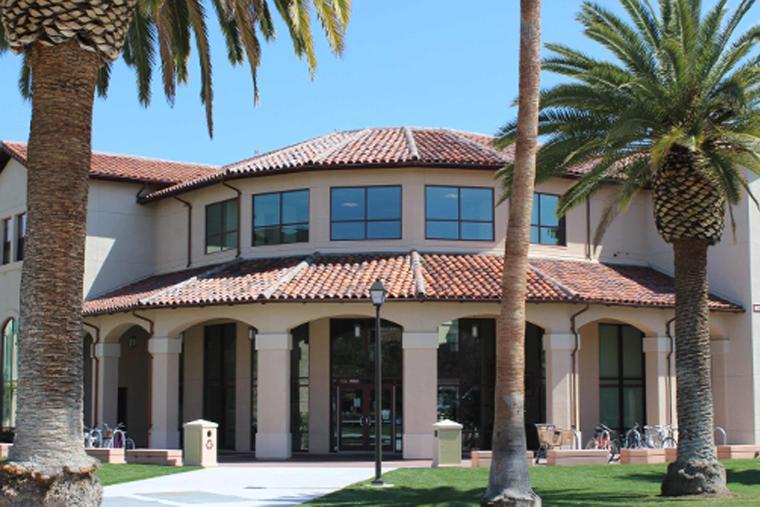Although all residence halls on campus have some sustainability features, Graham is a model example because it is our first residence hall that fulfilled LEED Gold standards.

Air
Graham is located within walking distance to Caltrain's Santa Clara Station and Santa Clara Valley Transportation Authority (VTA) bus stops, allowing students to travel throughout the Bay Area peninsula. Public transportation is essential to a healthy environment as it reduces congestion, saves gas, and helps to reduce our carbon footprint.
Residents are encouraged to ride bikes instead of using their cars, especially since Graham is a "zero-parking facility," meaning no new parking spaces were added to support the building. Bilking to and from class is common at SCU, and aside from reducing pollution, it is also a great way to stay fit and be outdoors.
Graham was built with construction materials that release fewer harmful pollutants into the air. Graham also has additional mechanical ventilation systems, which result in overall improved air quality in common spaces and residences. Off-gassing, or the release of Volatile Organic Compounds (VOCs) and other pollutants from common substances such as paint, stains, flooring, and insulation can affect health long after construction has been completed.
Energy
Graham's flat roofs are covered with reflective white roofing, reducing the amount of light that penetrates the building surface, keeping the entire building cooler during periods of hot weather. Reflective roofing reduces solar heat gain, lowers temperatures, and avoids transferring heat back into the atmosphere. This reduces the amount of air conditioning needed for the interior, thereby conserving energy.
Graham's high-efficiency windows substantially reduce heat loss/gains, and have multiple panes and insulated frames (which help block outside noise)-an added bonus for residents. In general, windows can account for 25-50% of a building's heating and cooling needs, so high-efficiency windows play a large part in reducing energy demands, while also saving money.
Graham features highly-efficient windows that insulate rooms and reduce the cooling during the colder winter months. When the windows are open, Graham's smart systems automatically shut off room heaters. Since Graham's smart systems and efficient building design already moderate comfortable room temperatures, residents do not need to use heating and air conditioning as often.
Materials
Residential units in Graham are established within a relatively small building footprint, which results in over 70% of the project site left as vegetated open space. An expansive area of vegetated open space promotes biodiversity and recreation. Buildings with smaller footprints consume less resources to build and use less energy to heat, cool, and power.
Graham has clearly marked recycling, waste, and compost bins throughout the building, with signs that make waste diversion for residents as easy as possible. Residence hall rooms also contain waste and recycling bins. Diverting waste to composting and recycling avoids sending waste to the landfill. More benefits include pollution prevention, emissions reduction, and natural resource conservation.
All the clay tile roofing used for Graham Hall, including those used on the cool room portions of the building, either came from the original Graham building or were salvaged from other locations on campus. Reuse of salvaged materials is more sustainable than recycling because it diverts materials from the waste stream with little or no processing of these materials. Reuse generally requires fewer resources, less energy, and less labor than recycling.
Water
Graham is one of the many campus buildings that offers water bottle filling stations, which were first installed in the summer of 2011 as part of SCU's Water Bottle Free initiative. Rather than purchasing single-use plastic bottles, students save money and avoid unnecessary waste by refilling their reusable water bottles at these stations.
Over 85% of our 106-acre campus is irrigated with recycled water, indicated by purple pipes and signs. Recycled water has led to a 30% decrease in water costs as well as an overall decrease in potable water usage by 60%. Recycled water can satisfy most water demands, with the exception of drinking, as long as it is adequately treated to ensure water quality appropriate for the use.
Graham manages stormwater runoff with on-site rain gardens. These are small depressions in the land, filled with soils and native plants that absorb and filter runoff. Runoff may carry harmful pollutants such as oil, dirt, and chemicals to streams and rivers. Rain gardens limit the extent to which these pollutants compromise water quality.
The average American uses 176 gallons of water per day, mainly for drinking and hygiene purposes. Graham's sustainable fixtures save residents 38% more water than fixtures without 'low-flow' technology. The installation of 'low-flow' toilets, faucets, and showers, as well as water-free urinals, not only conserves water but also saves money over time.